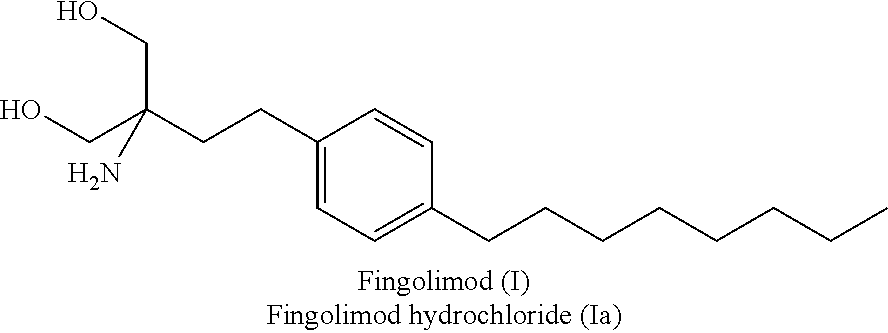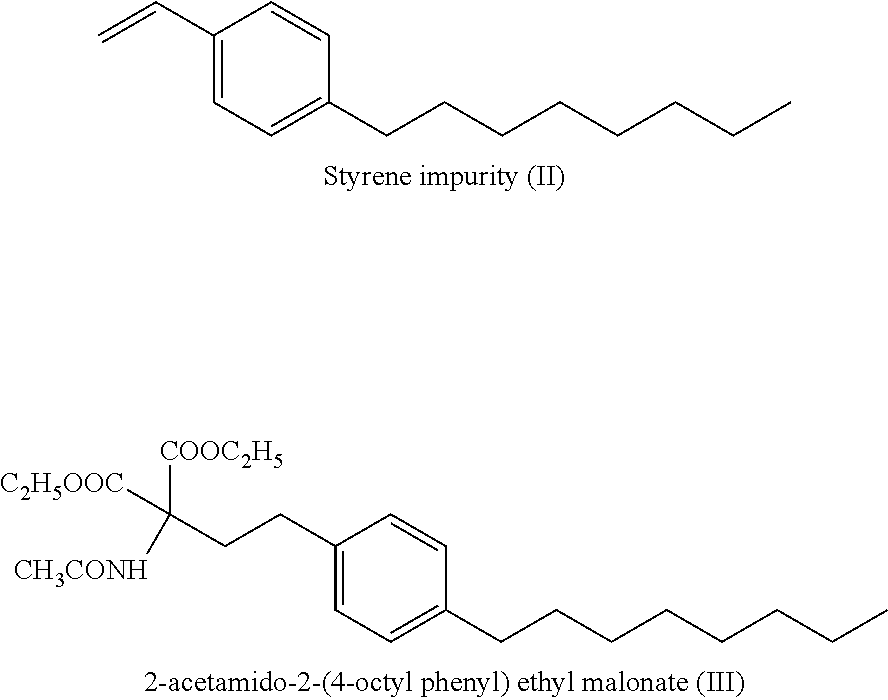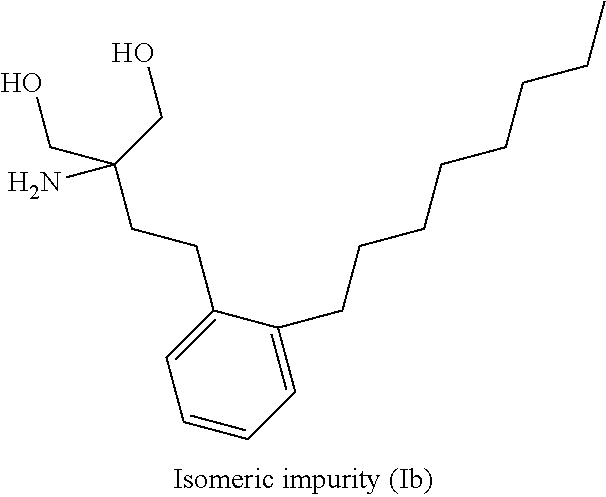Fingolimod hydrochloride process
a technology of fingolimod and hydrochloride, which is applied in the preparation of carboxylic acid amides, chemistry apparatus and processes, and organic chemistry, etc. it can solve the problems of significant increase in the cost of manufacture on a commercial scale, low yield, and styrene impurity formation to the extent of 5-10%, and achieve cost-effective effects
- Summary
- Abstract
- Description
- Claims
- Application Information
AI Technical Summary
Benefits of technology
Problems solved by technology
Method used
Image
Examples
example 1
Preparation of 2-(4-octylphenyl)ethyl iodide (IV)
[0037]A mixture of 2-(4-Octylphenyl)ethanol (100 gms; 0.427 moles), dichloromethane (500 ml) and triethylamine (108 gms, 1.067 moles) were cooled between 0° C. and 5° C. Methanesulfonyl chloride (73.11 gms, 0.64 moles) was added gradually under nitrogen atmosphere and stirred for 2-5 hours between 0° C. and 30° C., till completion of the reaction based on TLC monitoring. The reaction mixture was quenched with water (500 ml) and organic layer after separation was concentrated under reduced pressure to yield the corresponding mesyl derivative, which was dissolved in methyl isobutyl ketone (1064 ml) containing tetrabutyl ammonium iodide (7.85 gms) and sodium iodide (139.7 gms). The reaction mixture was stirred for 3 hours and after completion of reaction, the mixture was quenched with water (665 ml) and the organic layer concentrated under reduced pressure to give 2-(4-octylphenyl)ethyl iodide (IV).
Yield: 150 gms (96.53%)
example 2
Preparation of diethyl 2-acetamido-2-(4-octylphenyl) ethyl malonate (III)
[0038]Diethyl acetamidomalonate (59.86 gms), cesium carbonate (89.67 gm, 0.27 moles) and tetrabutyl ammonium iodide (21.42 gms; 0.05 moles) in DMSO (400 ml) were stirred at 25 to 30° C. 2-(4-Octylphenyl)ethyl iodide (IV) (100 gms, 0.29 moles) was gradually added to the reaction mixture under nitrogen atmosphere and stirred at 80 to 85° C. till completion of reaction. The reaction mixture was filtered, mixed with 1% potassium hydrogen sulfate solution, cooled to 0 to 5 C and filtered. The obtained solid was mixed with ethyl acetate and water was added to the mixture. Separation and concentration of the organic layer provided a residue containing 2-acetamido-2-(4-octylphenyl)ethyl malonate (III) which was crystallized from hexane.
Yield: 110.8 gms (88%);
Purity: 99.9%
example 3
Preparation of Fingolimod Hydrochloride
[0039]2-Acetamido-2-(4-octylphenyl)ethyl malonate (III) (100 gms, 0.23 moles) was dissolved, in isopropyl alcohol and cooled to 5-10° C. Sodium borohydride (43.8 gms) and calcium chloride (55.0 gms) were gradually added below 10° C. and stirred for 3-4 hours at 25 to 30° C. After completion of reaction, based on TLC, the reaction mixture was quenched with water and extracted with ethyl acetate (700 ml). The organic layer was concentrated under reduced pressure and the residue treated with hydrochloric acid dissolved in isopropyl alcohol and stirred for 2-3 hours at 80 to 100° C. The reaction mixture was cooled to 5-10° C., quenched with sodium carbonate solution (20%) and extracted with ethyl acetate. The organic layer was concentrated under reduced pressure to yield a residue containing fingolimod free base.
[0040]Isopropyl alcohol containing hydrochloride acid was added to the residue and stirred for 1 hour. The mixture was stirred at 5-10° C....
PUM
| Property | Measurement | Unit |
|---|---|---|
| Fraction | aaaaa | aaaaa |
Abstract
Description
Claims
Application Information
 Login to View More
Login to View More - R&D
- Intellectual Property
- Life Sciences
- Materials
- Tech Scout
- Unparalleled Data Quality
- Higher Quality Content
- 60% Fewer Hallucinations
Browse by: Latest US Patents, China's latest patents, Technical Efficacy Thesaurus, Application Domain, Technology Topic, Popular Technical Reports.
© 2025 PatSnap. All rights reserved.Legal|Privacy policy|Modern Slavery Act Transparency Statement|Sitemap|About US| Contact US: help@patsnap.com



